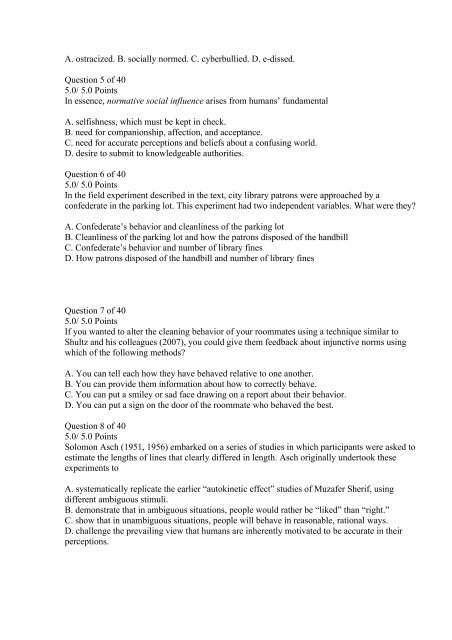S06 SOCIAL PSYCHOLOGY EXAM 5 Answers (Ashworth College)
You also want an ePaper? Increase the reach of your titles
YUMPU automatically turns print PDFs into web optimized ePapers that Google loves.
A. ostracized. B. socially normed. C. cyberbullied. D. e-dissed.<br />
Question 5 of 40<br />
5.0/ 5.0 Points<br />
In essence, normative social influence arises from humans’ fundamental<br />
A. selfishness, which must be kept in check.<br />
B. need for companionship, affection, and acceptance.<br />
C. need for accurate perceptions and beliefs about a confusing world.<br />
D. desire to submit to knowledgeable authorities.<br />
Question 6 of 40<br />
5.0/ 5.0 Points<br />
In the field experiment described in the text, city library patrons were approached by a<br />
confederate in the parking lot. This experiment had two independent variables. What were they?<br />
A. Confederate’s behavior and cleanliness of the parking lot<br />
B. Cleanliness of the parking lot and how the patrons disposed of the handbill<br />
C. Confederate’s behavior and number of library fines<br />
D. How patrons disposed of the handbill and number of library fines<br />
Question 7 of 40<br />
5.0/ 5.0 Points<br />
If you wanted to alter the cleaning behavior of your roommates using a technique similar to<br />
Shultz and his colleagues (2007), you could give them feedback about injunctive norms using<br />
which of the following methods?<br />
A. You can tell each how they have behaved relative to one another.<br />
B. You can provide them information about how to correctly behave.<br />
C. You can put a smiley or sad face drawing on a report about their behavior.<br />
D. You can put a sign on the door of the roommate who behaved the best.<br />
Question 8 of 40<br />
5.0/ 5.0 Points<br />
Solomon Asch (1951, 1956) embarked on a series of studies in which participants were asked to<br />
estimate the lengths of lines that clearly differed in length. Asch originally undertook these<br />
experiments to<br />
A. systematically replicate the earlier “autokinetic effect” studies of Muzafer Sherif, using<br />
different ambiguous stimuli.<br />
B. demonstrate that in ambiguous situations, people would rather be “liked” than “right.”<br />
C. show that in unambiguous situations, people will behave in reasonable, rational ways.<br />
D. challenge the prevailing view that humans are inherently motivated to be accurate in their<br />
perceptions.

















